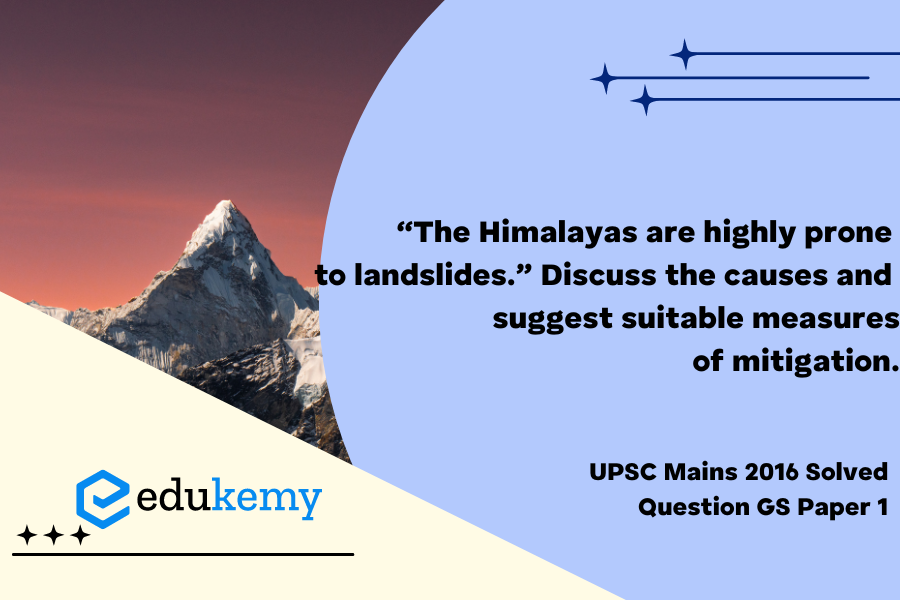The Himalayas, characterized by their breathtaking beauty and towering peaks, are also known for their high susceptibility to landslides. This natural hazard poses significant threats to the region’s ecosystems, infrastructure, and the lives of those residing in the vicinity. The primary causes of landslides in the Himalayas are manifold, stemming from the complex geological and topographical features of the region. Steep slopes, tectonic activity, intense monsoon rains, and the fragile nature of the rock and soil composition contribute to the heightened vulnerability. The monsoons, in particular, trigger soil erosion and saturation, making the already precarious slopes even more prone to mass movements.
Tag: Important Geophysical phenomena such as earthquakes, Tsunami, Volcanic activity, cyclones etc., geographical features and their location-changes in critical geographical features.
Contents
Decoding the Question:
- In Introduction, start with the definition of landslide and give some facts by GSI and NDMA about the landslides. Show the severity of landmass in Himalayan region.
- In Body,
- Give reason for the causes of landslides in the Himalayan regions.
- Suggest measures to mitigate and minimise the risk reduction.
- Conclude with the NDMA guideline to mitigate the landslides.
Answer:
Landslides are simply defined as the mass movement of rock, debris or earth down a slope and have come to include a broad range of motions whereby falling, sliding and flowing under the influence of gravity dislodges earth material. According to the Geological Survey of India (GSI), roughly 15% of India’s landmass is highly vulnerable to landslides. The National Disaster Management Authority (NDMA) lists the Himalayan states as the most landslide-prone areas and places them in the category of Very High Landslide Vulnerability Zones.

The Causes for Landslide in the Himalayan Region:
- Geology and Tectonic Activity: The Himalayan region is geologically young and characterised by active tectonic processes, such as the collision of the Indian and Eurasian plates. This tectonic activity leads to the uplift of mountains and the formation of unstable rock formations, making the region prone to landslides.
Example: The 2018 Kedarnath landslide in Uttarakhand, India, was triggered by heavy rainfall and occurred in a region with complex geology and tectonic activity. The landslide resulted in significant loss of life and property damage.
- Seismic Activity: The Himalayan region is seismically active due to ongoing tectonic movements. Earthquakes can lead to ground shaking and destabilise slopes, increasing the likelihood of landslides.

Example: The devastating earthquake in Nepal in 2015 triggered numerous landslides in the region, causing extensive damage to infrastructure and claiming thousands of lives.
- Heavy Rainfall: The Himalayan region receives heavy monsoonal rainfall during the summer months. Intense rainfall saturates the soil and weakens the stability of slopes, leading to landslides.
Example: In 2013, the Uttarakhand region experienced heavy rainfall during the monsoon season, which resulted in flash floods and landslides, causing widespread destruction and loss of life.
- Glacial Melting: Climate change has led to the melting of glaciers in the Himalayan region. The meltwater can lubricate the base of slopes, reducing friction and increasing the likelihood of landslides.
Example: In 2018, a massive landslide occurred in Kinnaur district, Himachal Pradesh, India, triggered by glacial melting. The landslide blocked a major highway and caused disruptions in transportation.
- Deforestation and Land Use Changes: Human activities, such as deforestation, construction of roads, and urbanisation, can alter the natural landscape and slope stability, increasing the susceptibility of the region to landslides.
Example: The construction of roads and infrastructure in hilly areas without proper engineering and slope management can lead to landslides, such as the one that occurred in Malin village, Maharashtra, India, in 2014, resulting in the loss of an entire village.
Suitable Measures of Mitigation and Possible Risk Reduction:
- Landslide Zoning & Hazard Mapping: The Geological Survey of India (GSI) has conducted detailed landslide hazard mapping in regions like Uttarakhand and Himachal Pradesh. This mapping helps identify high-risk areas and informs land use planning and disaster management strategies.
- Early Warning Systems: The Ministry of Earth Sciences (MoES) operates the Integrated Landslide Early Warning System (ILEWS) in select landslide-prone regions, including Sikkim and Darjeeling. This system uses real-time rainfall data and ground movement monitoring to provide early warnings to communities and authorities.
- Slope Stabilization & Engineering Measures: In Uttarakhand, various engineering measures, such as the construction of retaining walls and slope reinforcement with rock bolts, have been implemented to stabilise vulnerable slopes along highways and roads.
- Disaster Preparedness and Awareness: The National Disaster Management Authority (NDMA) conducts workshops and awareness campaigns in states like Uttarakhand and Arunachal Pradesh to educate communities about landslide risks and preparedness measures.
- Land Use Planning and Development Control: In landslide-prone areas of the Western Ghats and the Northeastern states, local authorities have designated certain regions as no-build zones to prevent construction in high-risk areas.
- Remote Sensing and GIS Technology: The National Remote Sensing Centre (NRSC) and the Indian Space Research Organisation (ISRO) use satellite-based remote sensing and GIS technology to monitor and assess landslide-prone areas, aiding in disaster management and decision-making
Thus,the National Disaster Management Authority has given comprehensive guidelines on the management of landslides to whittle down their destructive potential and minimise the consequential losses In fact, the management of landslides requires a coordinated and multi-faceted approach among many stakeholders strengthened by the requisite operational, legal, institutional, and financial support.
In case you still have your doubts, contact us on 9811333901.
For UPSC Prelims Resources, Click here
For Daily Updates and Study Material:
Join our Telegram Channel – Edukemy for IAS
- 1. Learn through Videos – here
- 2. Be Exam Ready by Practicing Daily MCQs – here
- 3. Daily Newsletter – Get all your Current Affairs Covered – here
- 4. Mains Answer Writing Practice – here


